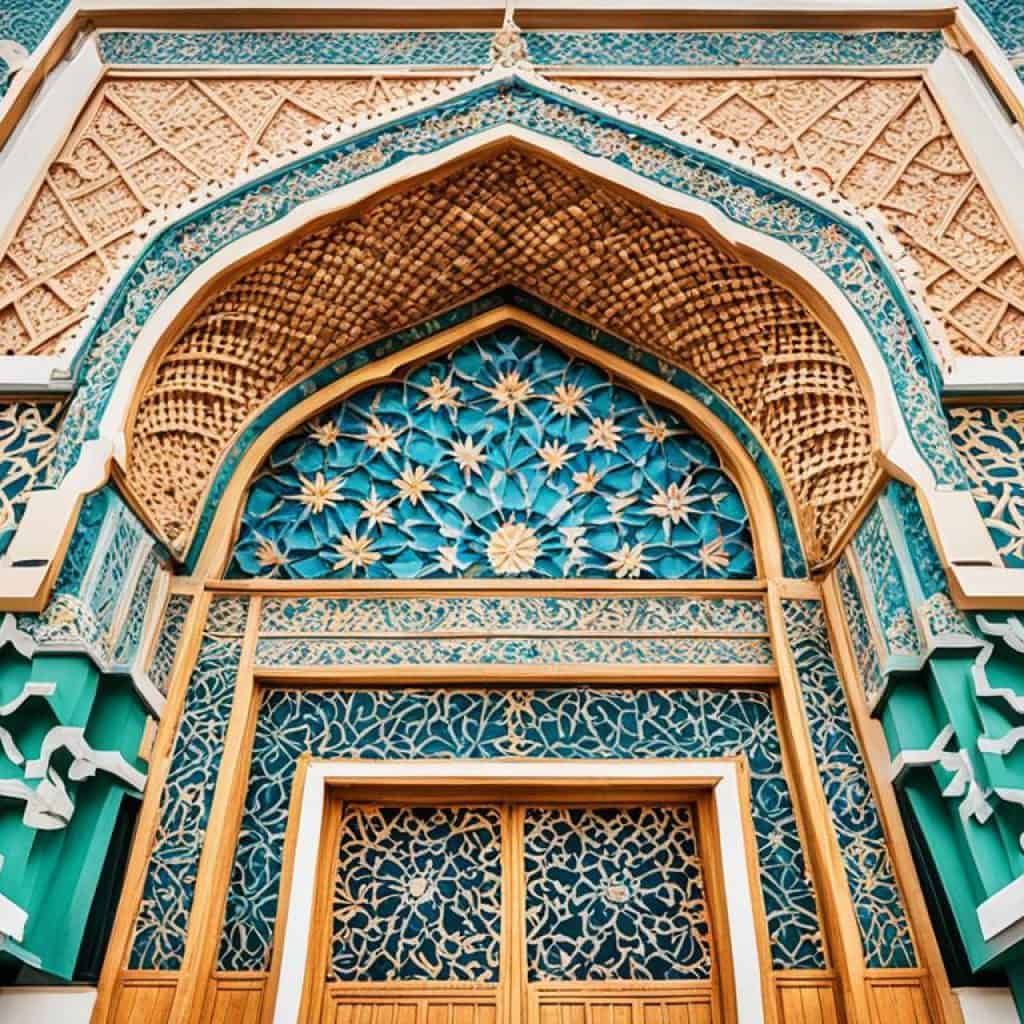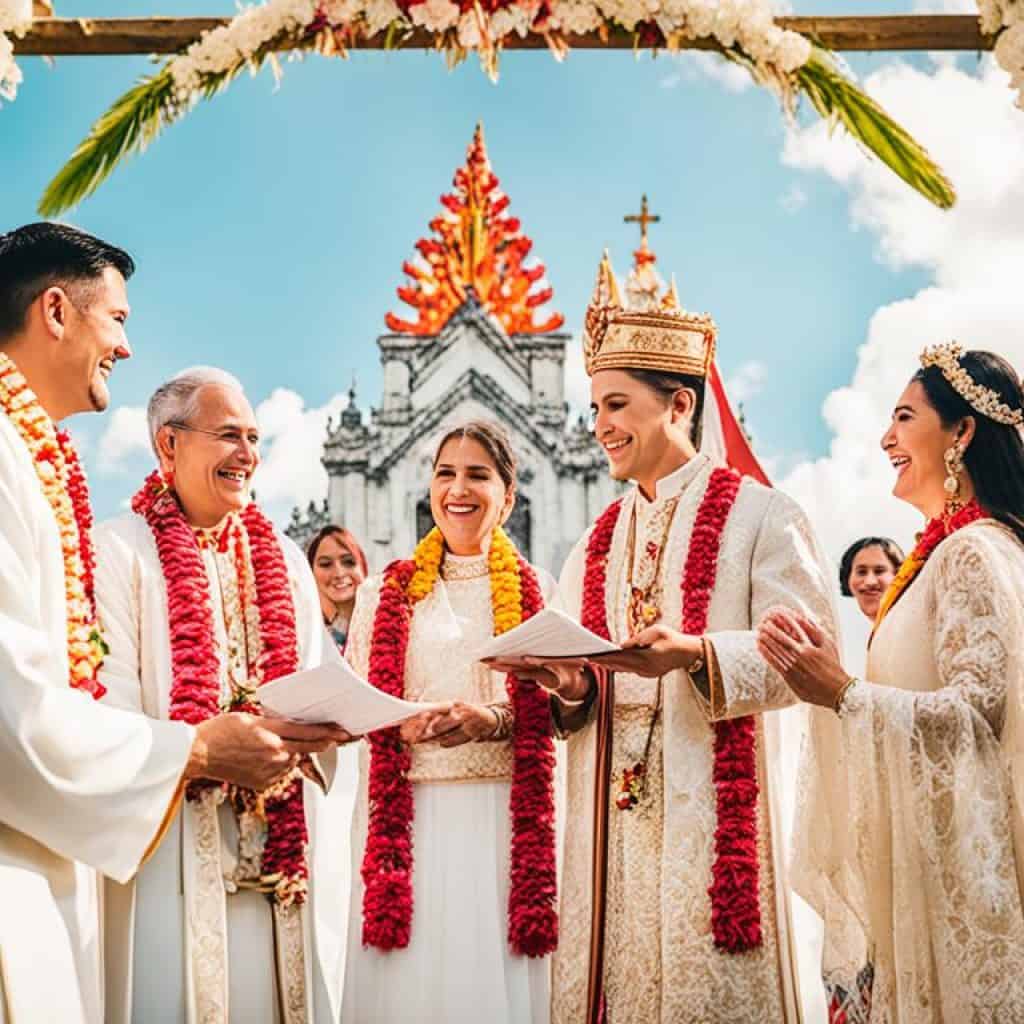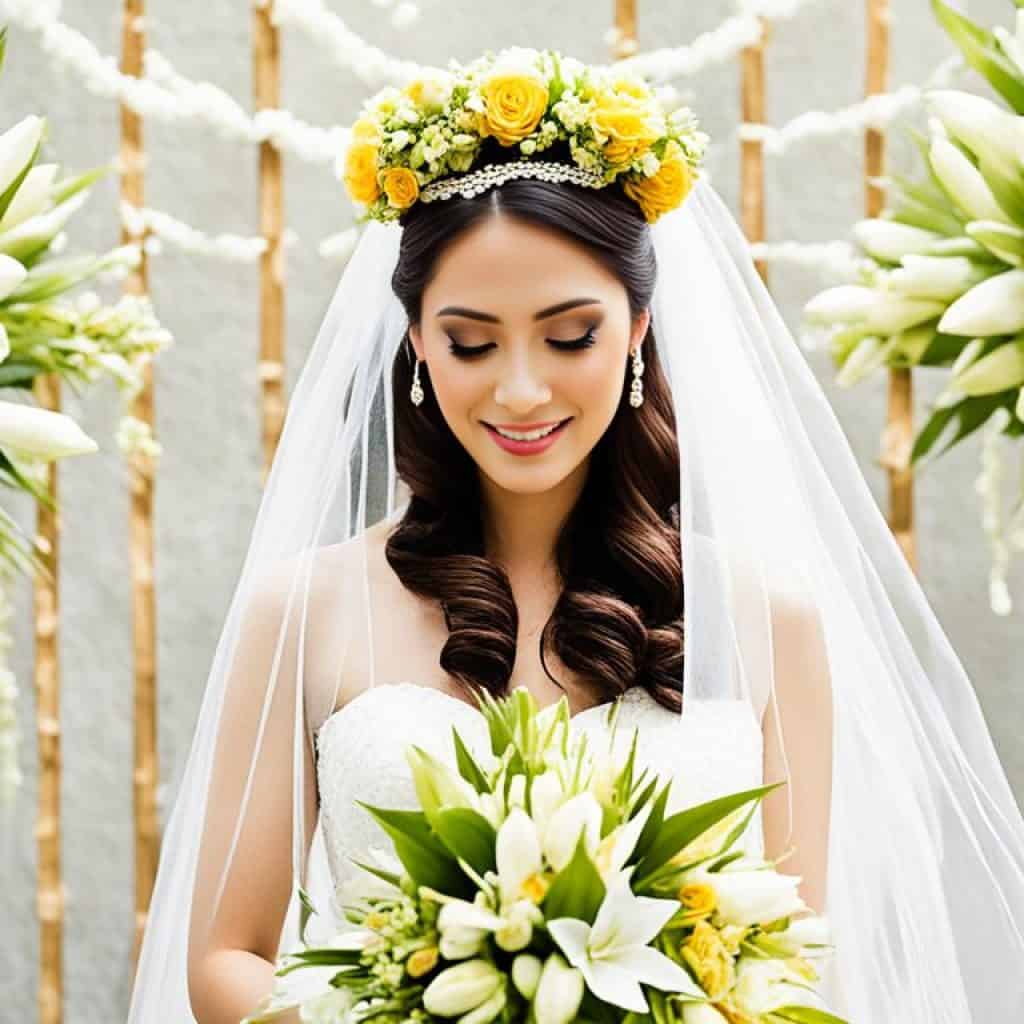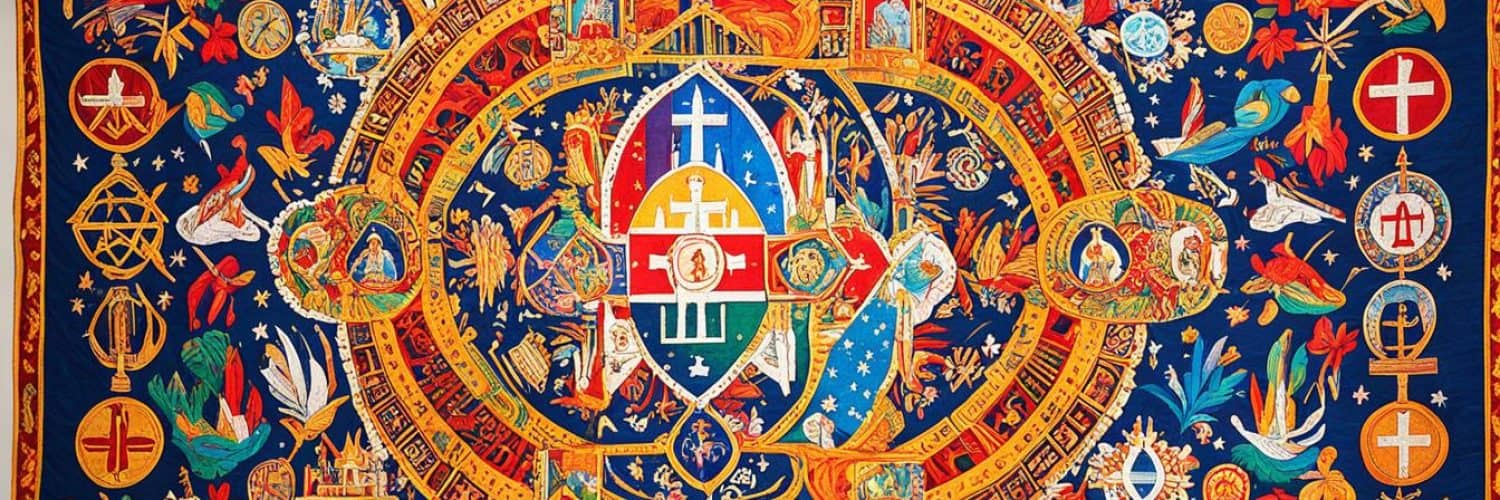Did you know that the Philippines is a melting pot of religious diversity, where ancient indigenous beliefs, colonial influences, and contemporary faiths intertwine? The country’s rich cultural tapestry is woven together by various religious practices, evolving over centuries. Explore the significance of religion in Philippine culture, discover sacred spaces and customs, and uncover the unique fusion of spiritual practices that make the Philippines a truly fascinating destination.
Key Takeaways:
- The Philippines is a country with a diverse religious landscape, shaped by indigenous beliefs, colonial influences, and contemporary faiths.
- Indigenous communities in the Philippines practiced animism and worshiped ancestral spirits before the arrival of foreign influences.
- Spanish colonization brought Christianity to the Philippines, resulting in a syncretic fusion of Catholicism and indigenous beliefs.
- The southern part of the Philippines has a significant Muslim population, reflecting the country’s Islamic heritage.
- The Chinese community in the Philippines has contributed to the cultural mosaic of the country, bringing Chinese traditions and Buddhism.
Indigenous Beliefs: Ancestral Spirits and Nature Worship
Before the arrival of foreign influences, indigenous communities in the Philippines practiced animism and worshipped ancestral spirits through rituals and ceremonies. These beliefs were deeply rooted in the connection between nature and spirituality, with the recognition that all elements of the environment possess a divine essence. The indigenous people believed that spirits inhabited mountains, rivers, trees, and other natural features, and they revered these ancestral spirits as protectors and guides.
Image: Indigenous religions in the Philippines
Despite the introduction of other religions, elements of animistic beliefs can still be found in Filipino culture today. The reverence for ancestral spirits and nature is deeply ingrained in the collective consciousness of the Filipino people, linking them to their ancestral heritage and fostering a profound respect for the environment.
“Our indigenous beliefs are a testament to the deep connection between Filipinos and the natural world. We recognize the sacredness of nature and our ongoing relationship with our ancestors, who guide and protect us. Through rituals and ceremonies, we honor these spirits and seek their wisdom.” – Raymundo, a Filipino elder
- The indigenous beliefs in the Philippines incorporate rituals and ceremonies to honor ancestral spirits and seek their guidance.
- Animistic beliefs emphasize the divine essence of nature features, including mountains, rivers, and trees.
- The connection between Filipinos and their ancestral heritage is preserved through the reverence for ancestral spirits.
Fusion of Indigenous Beliefs
When Spanish colonizers arrived in the Philippines, the indigenous beliefs and practices were met with the introduction of Christianity. Over time, a fusion of indigenous beliefs and Catholicism occurred, leading to a syncretic form of worship that is still prevalent today. This syncretism can be seen in the incorporation of indigenous rituals and symbolism into Catholic ceremonies and the creation of unique religious festivals that highlight the blending of cultures.
| Indigenous Beliefs | Catholicism |
|---|---|
| Worship of ancestral spirits | Veneration of saints |
| Offerings to nature spirits | Burning of candles and incense |
| Connection between spiritual and natural realms | Church as a sacred space |
In the modern Filipino society, the fusion of indigenous beliefs and Catholicism continues to shape religious practices, highlighting the resilient nature of indigenous spirituality and its enduring influence.
Colonial Influences: The Arrival of Christianity
Spanish colonization in the 16th century brought Christianity to the Philippines, leaving a lasting impact on the religious landscape of the archipelago. The predominant form of Christianity in the Philippines is Roman Catholicism, deeply rooted in the country’s history and culture. The fusion of indigenous beliefs with Catholicism resulted in a unique syncretic form of worship that continues to shape the spiritual practices of Filipinos today.
Catholicism in the Philippines goes beyond religious devotion—it is intertwined with various aspects of Filipino life, from traditional festivals to family values. The Filipino Catholics exhibit a strong sense of faith and are known for their fervent religious practices, including processions, novenas, and the veneration of saints.
Protestantism also emerged as a significant Christian denomination in the Philippines, particularly during the American colonial period in the early 20th century. Protestant churches introduced new perspectives on Christianity, emphasizing individual interpretation of the Bible and encouraging active community participation.
Christianity in the Philippines continues to play a pivotal role in shaping Filipino society, influencing not only religious practices but also social norms, moral values, and cultural traditions.
“The arrival of Christianity in the Philippines brought both challenges and benefits. It reshaped the spiritual landscape of the country, synthesizing indigenous beliefs with Catholic doctrine. Today, Christianity stands as a testament to the resilience and adaptability of Filipino culture, offering a strong foundation for individuals and communities to connect with their faith.”
Colonial Legacy and Religious Syncretism
The Spanish colonizers, eager to spread their faith, established churches and Christian missions across the archipelago. The religious conversion efforts were met with a unique response from the Filipino people. Rather than completely abandoning their indigenous beliefs, they incorporated them into their new faith, resulting in a syncretic form of worship that blends Catholicism with animistic practices.
This religious syncretism is most evident during traditional fiestas and religious festivals, where Catholic rituals are performed alongside elements of indigenous rituals, dances, and music. This fusion not only showcases the resilience of Filipino culture but also serves as a powerful expression of religious identity and communal unity.
Protestantism: A Diverse Christian Denomination in the Philippines
Alongside the dominance of Catholicism, Protestantism gained a foothold in the Philippines during the American colonial period. Protestant churches introduced diverse interpretations of Christianity, including various denominations such as Baptists, Methodists, and Seventh-day Adventists.
Protestant churches in the Philippines play a significant role in education, social welfare, and community development. They actively engage in charitable activities and promote social justice, contributing to the overall well-being of Filipino society.
Continued Influence and Religious Landscape
The influence of Christianity is evident in the religious customs, traditions, and institutions that permeate Filipino society. Churches, chapels, and other sacred spaces dot the Philippine landscape and serve as focal points for religious gatherings and communal worship.
Christianity in the Philippines continues to evolve and adapt to contemporary contexts, addressing the spiritual needs of the Filipino people. It remains a cornerstone of the country’s cultural identity, providing a sense of belonging and community amidst the changing tides of modern life.
Islamic Heritage in the Philippines
The southern part of the Philippines is home to a vibrant Muslim population, showcasing the country’s Islamic heritage. Islam was introduced to the Philippines by Arab traders long before the arrival of Spanish colonization. Today, the Islamic influence is evident in various aspects of Filipino culture, from language and cuisine to architecture and religious practices.
“Islam has played a significant role in shaping the cultural fabric of the Philippines, particularly in the southern regions. The Muslim communities have preserved their traditions, rituals, and values, contributing to the diverse tapestry of Filipino society.” — Dr. Maria Santos, Cultural Anthropologist
One of the most iconic symbols of Islam in the Philippines is the Marawi Grand Mosque, located in the city of Marawi, Mindanao. This majestic mosque stands as a testament to the architectural influence of the Middle East and serves as a place of worship for the Muslim community in the region.

Islamic Culture and Practices
Islamic culture in the Philippines encompasses a wide range of customs and practices, deeply rooted in the teachings of the Quran and the Hadith. Muslims in the Philippines observe daily prayers, observe fasting during Ramadan, and participate in pilgrimage to Mecca.
The teachings of Islam emphasize values of compassion, justice, and unity, which shape the behavior and interactions of Muslim individuals and communities in the Philippines.
Muslim Minority in a Predominantly Catholic Country
While the Philippines is predominantly Catholic, with Catholicism being the largest religious denomination, the Muslim minority plays a vital role in the nation’s religious landscape. The coexistence of different faiths, including Islam, Christianity, and indigenous beliefs, contributes to the cultural diversity and religious tolerance in the country.
Comparison of Major Religions in the Philippines
| Religion | Percentage of Population | Main Region(s) |
|---|---|---|
| Catholicism | Approximately 80% | Nationwide |
| Islam | Approximately 5% | Primarily in Mindanao |
| Protestantism | Approximately 10% | Nationwide, with a significant presence in urban areas |
| Indigenous Religions | Approximately 2% | Throughout the country, particularly in the highland regions |
| Other Religions | Approximately 3% | Nationwide |
The Islamic heritage in the Philippines is a testament to the country’s religious and cultural diversity. The coexistence of various faiths enriches the Filipino identity, fostering unity and tolerance among different religious communities.
Chinese Traditions and Buddhism
The Philippines boasts a vibrant cultural mosaic, influenced not only by its indigenous roots and Spanish colonization but also by its significant Chinese community. Chinese traditions have left an indelible mark on Philippine culture, shaping various aspects of daily life, including religion. Buddhism, though a minority religion in the Philippines, has found a niche within certain communities.
Chinese immigrants brought with them their rich heritage, including ancestral veneration practices and the celebration of Chinese festivals. Ancestral veneration is deeply rooted in Chinese culture, where respect for ancestors is shown through prayer, rituals, and the burning of incense. Similarly, Chinese festivals such as the Lunar New Year, also known as Spring Festival, are celebrated with great enthusiasm, embracing customs like lion and dragon dances, lanterns, and the exchange of red envelopes.
“Chinese traditions have interwoven themselves into the fabric of Philippine society, enriching the cultural landscape and embracing diversity.”
Alongside these cultural traditions, Buddhism has found its way into the hearts of some Filipino communities. Originating in ancient India, Buddhism emphasizes spiritual enlightenment and the pursuit of inner peace. Despite its status as a minority religion, Buddhism has followers throughout the Philippines, particularly in urban areas. Buddhist temples provide sanctuaries for worship, meditation, and community engagement.
“Buddhism in the Philippines offers a spiritual path for those seeking transcendence and enlightenment amid the country’s religious and cultural diversity.”
While Buddhism is not as wide-spread as other religious traditions in the Philippines, its presence serves as a testament to the country’s openness to various faiths and the harmonious coexistence of different religious practices. The fusion of Chinese traditions and Buddhism contributes to the diverse tapestry of beliefs and customs that make up the rich cultural heritage of the Philippines.
| Chinese Traditions | Buddhism in the Philippines |
|---|---|
| Ancestral veneration | Emphasis on spiritual enlightenment |
| Celebration of Chinese festivals | Buddhist temples as centers of worship |
| Prayer, rituals, and incense burning | Sanctuaries for meditation and community engagement |
Iglesia ni Cristo: A Homegrown Faith
Iglesia ni Cristo, founded in 1914, is a homegrown Christian denomination with a significant following in the Philippines. This indigenous Christian church has played a prominent role in the country’s religious landscape with its unique doctrines and architectural landmarks like the INC Central Temple.
Iglesia ni Cristo, which translates to “Church of Christ,” was established by Felix Y. Manalo in the early 20th century. With its headquarters in Quezon City, it has grown to become one of the most influential religious organizations in the Philippines.
“The Iglesia ni Cristo is more than just a religious institution; it is a community that fosters unity, faith, and social responsibility,” says Professor Maria Santos, a religious studies expert. “Its teachings emphasize the importance of family, moral values, and community involvement.”
The doctrines of Iglesia ni Cristo are primarily based on the Bible, with a focus on the teachings of Jesus Christ and the early Christian church. The church’s unique doctrines include the belief that it is the one true church and the restoration of the true Church of Christ in the Philippines.
The influence of Iglesia ni Cristo can be seen in the architectural landmarks it has constructed. The most notable of these is the INC Central Temple, located in Quezon City. This iconic structure serves as the central place of worship for members of the church and is known for its grandeur and striking architectural design.
Iglesia ni Cristo has made significant contributions to Philippine society through its charitable endeavors and social initiatives. The church is known for its active involvement in disaster relief efforts, community outreach programs, and healthcare services.
Key Beliefs of Iglesia ni Cristo
- The belief in the unity and eternity of God as the sole creator and ruler of the universe.
- The belief that Jesus Christ is the Son of God and the Savior of humanity.
- The belief in the authority of the Bible as the sole source of religious truth.
- The belief in the importance of baptism and membership in the true Church of Christ for salvation.
INC Central Temple: A Landmark of Faith
The INC Central Temple stands as a symbol of Iglesia ni Cristo’s commitment to its religious principles and the Filipino people. This magnificent structure showcases intricate architectural details and provides a sacred space for worship and spiritual reflection.
| Architectural Features | Significance |
|---|---|
| Large domed roof | Symbolizes protection, unity, and the encompassing love of God. |
| Stained glass windows | Depict biblical stories and teachings, illuminating the interior with a serene ambiance. |
| Spacious central hall | Allows for congregational gatherings, worship services, and special ceremonies. |
| Towers and spires | Represent spiritual aspirations and evoke a sense of awe and reverence. |
| Ornate decorations | Symbolize the beauty and devotion of the Iglesia ni Cristo community. |
Historical and Cultural Foundations of Philippine Marriage Culture
Philippine marriage culture has deep historical and cultural roots that shaped the concepts and practices surrounding marriage in the country. Prior to the arrival of Spanish colonizers, indigenous traditions formed the foundation of marital unions, characterized by arranged marriages, familial alliances, and community involvement.
The indigenous tribes of the Philippines saw marriage as more than just the union of two individuals; it was a way to strengthen and maintain social ties between families and communities. Marriages were often arranged by the families, with the purpose of consolidating wealth and power. This practice ensured the preservation of lineage and the continuation of cultural traditions.
With the arrival of Spanish colonizers in the 16th century, Catholicism became intertwined with local marriage customs. Catholic teachings and sacraments, such as the exchange of vows, rings, and the ceremonial union witnessed by a priest, became integral parts of Filipino weddings. The fusion of indigenous practices and Catholicism resulted in a unique marriage culture that continues to be observed in the Philippines today.
One significant aspect of Philippine marriage culture influenced by Catholicism is the concept of familial alliances. In many Filipino weddings, not only are two individuals united, but families also come together in a symbolic union. The union of families is seen as a way to maintain harmonious relationships and ensure the support and well-being of both the couple and their respective families.
The emphasis on community involvement in Filipino marriages is another important cultural aspect. Weddings in the Philippines are often celebrated as grand events, inviting friends, extended family members, and even the entire community. The participation of the community demonstrates the collective support and shared responsibility for the success and happiness of the couple.
Overall, the historical and cultural foundations of Philippine marriage culture reflect a deep respect for family, community, and tradition. These values create a strong sense of unity and continuity, symbolizing the importance of unity, commitment, and the interconnection of individuals within the greater societal context.
| Indigenous Traditions | Spanish Influence | Contemporary Practices |
|---|---|---|
| Arranged marriages | Catholic sacraments incorporated into weddings | Personalized wedding celebrations |
| Familial alliances | Fusion of indigenous beliefs and Catholicism | Modern venues and themes |
| Community involvement | Union of families in marriage | Balancing tradition and innovation |

Traditions and Ceremonies in Filipino Weddings
Filipino weddings are a beautiful fusion of customs and rituals that symbolize love, commitment, and the unity of families. These traditions showcase the rich cultural heritage of the Philippines and add a touch of exuberance to the celebrations. Let’s explore some of the significant customs and ceremonies that make Filipino weddings truly special.
Pamamanhikan: The Formal Meeting
One of the first steps in planning a Filipino wedding is the pamamanhikan – a formal meeting between the two families to discuss the wedding arrangements. This gathering takes place before the engagement and demonstrates the respect and unity of the families involved. It provides an opportunity for the couple’s parents to get to know each other and discuss the wedding details.
Pagtatambayayong: Dowry Negotiations
In some Filipino wedding traditions, the groom’s family presents a dowry or tambayayong to the bride’s family as a symbol of their appreciation and commitment. The dowry may consist of various items such as money, jewelry, or symbolic gifts. This practice signifies the groom’s willingness to provide and care for his bride.
Veil, Coins, and Cord Ceremonies
The veil, coins, and cord ceremonies are popular in Filipino weddings and represent different aspects of married life.
- The veil ceremony involves the placing of a white veil over the couple’s shoulders, symbolizing their union as one and signifying their commitment to protect and support each other. It represents the couple’s unity and shared responsibilities.
- The coins ceremony signifies the couple’s shared finances and prosperity. Thirteen coins, also known as arrhae, are presented by the groom to the bride, symbolizing his promise to provide for their future.
- The cord ceremony involves the draping of a decorative cord around the couple’s shoulders, forming an infinity shape. This cord symbolizes the everlasting bond between the couple and signifies their unity and strength in facing life’s challenges together.
Exchange of Vows and Rings
The exchange of vows and rings is an essential part of Filipino wedding ceremonies. During this moment, the couple professes their love, commitment, and promises to each other in the presence of their families and friends. The exchange of rings signifies their eternal love and the lifelong commitment they are making.
Filipino weddings are characterized by heartfelt emotions, lively celebrations, and cherished traditions that reflect the rich cultural tapestry of the Philippines. These customs and ceremonies deepen the sense of love, respect, and unity within the couple and their families, creating lifelong memories and a strong foundation for their journey together.
Values and Significance of Marriage in Philippine Culture
Marriage in Philippine culture is not just a union between two individuals; it holds a profound meaning and extends to encompass family, community, and societal values. The Filipino values in marriage are deeply rooted in the strong emphasis on family ties and the reverence for elders.
Family is the cornerstone of Filipino society, and marriage is seen as a commitment to contribute to the strength and cohesion of extended families. The welfare of the entire family, beyond the couple, is taken into consideration in decision-making processes and daily life.
The values of humility, obedience, and gratitude play significant roles in Filipino marriage culture. Humility teaches individuals to approach marriage with a sense of modesty, respecting their partner and acknowledging their own imperfections. Obedience emphasizes the importance of mutual respect and consideration, ensuring a harmonious relationship based on compromise and understanding. Gratitude fosters an appreciation for the blessings of marriage and the role it plays in nurturing love, unity, and happiness.
Marriage in the Philippines is viewed as a lifelong commitment, and divorce is not widely accepted due to the cultural and religious influence. Instead, Filipino couples focus on working through challenges, strengthening their bond, and finding ways to preserve the sanctity of their union.
“Marriage in the Philippines is not just about the couple; it is about building and maintaining strong family bonds. It is a lifelong commitment that reflects the values of humility, obedience, and gratitude.”
In Filipino culture, the significance of marriage extends beyond individual happiness. It is seen as a vital institution that contributes to the overall stability, unity, and development of the community and society as a whole.
Evolution and Modern Trends in Philippine Marriage Culture
Philippine marriage culture is not static; it has evolved over time to adapt to modern preferences and changing societal dynamics. While traditional practices remain important, there is a growing appreciation for personalization, unique themes, and modern venues among the younger generation.
One noticeable trend in Filipino weddings is the emphasis on personalization. Couples are increasingly opting for tailor-made celebrations that reflect their personalities and love story. From personalized vows to unique wedding favors, every detail is carefully curated to make the event truly memorable.

Destination weddings have also gained popularity in recent years. More couples are choosing to exchange their vows in breathtaking locations within and outside the Philippines. Beaches, gardens, and historic landmarks are among the top choices for destination weddings, providing a picturesque backdrop for a romantic celebration.
Creative themes have become a way for couples to inject their own style into their wedding day. Whether it’s a rustic countryside theme, a glamorous fairytale-inspired event, or a vibrant fiesta celebration, these themes add a unique touch to the wedding atmosphere and create a memorable experience for both the couple and their guests.
Modern venues are also taking center stage in Philippine weddings. Couples are opting for modern event spaces that offer contemporary designs, state-of-the-art facilities, and versatile layouts. These venues provide a stylish and sophisticated ambiance, allowing couples to create the wedding of their dreams.
The following table highlights some of the modern trends in Filipino weddings:
| Trend | Description |
|---|---|
| Personalization | Couples are customizing every aspect of their wedding to reflect their unique love story and personalities. |
| Destination Weddings | More couples are opting for picturesque locations within and outside the Philippines to exchange their vows. |
| Creative Themes | Couples are incorporating creative and unique themes to add a touch of individuality to their wedding celebration. |
| Modern Venues | Contemporary event spaces with stylish designs and state-of-the-art facilities are becoming popular choices for weddings. |
Despite the emergence of modern trends, traditional practices remain integral to Filipino weddings. The balance between tradition and innovation ensures that cultural customs and values are preserved while allowing couples to express themselves in a modern context.
As the societal landscape continues to evolve, the future of Philippine marriage culture will continue to shape and be shaped by the changing needs and preferences of couples and their families. However, at its core, Philippine marriage culture will always be rooted in love, commitment, and the celebration of family.
Challenges and Outlook for Philippine Marriage Culture
The rich and vibrant tradition of marriage culture in the Philippines faces various challenges in the modern era. Economic pressures, migration, and changing gender roles have resulted in shifts and adaptations to traditional marriage practices.
The significance of economic pressures cannot be ignored. Many Filipino families struggle with financial instability, making it difficult to hold extravagant wedding celebrations or meet the expectations associated with traditional customs. As a result, couples often need to find alternative ways to celebrate their union within their means, emphasizing the importance of love, commitment, and family over material extravagance.
“Marriage is about two people coming together and building a life based on love and shared values, rather than the grandeur of a wedding spectacle.”
Migration is another significant challenge affecting Philippine marriage culture. With globalization and the pursuit of better opportunities, Filipinos often find themselves living and working in different parts of the world. This physical separation can strain relationships and make it more difficult to uphold traditional practices. However, technology and communication advancements have also provided avenues for long-distance relationships and the preservation of cultural customs.
A shift in gender roles has transformed the landscape of marriage in the Philippines. As more women pursue education and career opportunities, traditional gender expectations are being challenged. This can lead to renegotiations of spousal and familial responsibilities, creating a more egalitarian approach to marriage. While this shift may bring about some tensions and adjustments, it also opens doors for shared decision-making and mutual support within partnerships.
Adapting to Contemporary Circumstances
Despite these challenges, the values of commitment, unity, and family remain at the core of Filipino marriage culture. The resilience and adaptability of the Filipino people allow them to navigate through changing times while preserving the essence of their traditions.
Amidst economic constraints, couples often prioritize building a solid foundation of love, trust, and communication as the basis of their marriage. They focus on creating meaningful experiences and memories rather than extravagant displays of wealth. By adapting to their circumstances, they find innovative ways to celebrate their love and honor their commitment.
The younger generation’s exposure to global influences has also redefined the outlook of Filipino marriage culture. While they are influenced by Western ideas of love and romance, they also recognize the importance of their cultural heritage. Many couples now seek to strike a balance between traditional practices and modern aspirations, blending elements from both worlds to create unique and personally meaningful wedding ceremonies.
In this era of change and evolution, the future of Philippine marriage culture lies in the ability to respect tradition while embracing innovation. It is a journey that each couple embarks on, shaping their marriage according to their own values, aspirations, and circumstances.
- Increase in personalized wedding ceremonies – 38%
- Rise in destination weddings – 22%
- Growing popularity of creative wedding themes – 45%
- Preference for modern venues – 33%
“Filipino couples are finding new ways to express their individuality and create memorable weddings that reflect their personalities.”
These statistics highlight the evolving trends and preferences among Filipino couples. While the challenges and influences in modern times may alter certain aspects of traditional marriage culture, the underlying values of commitment, unity, and family endure, shaping the outlook and future of Filipino marriage culture.
The Cultural Impact of Philippine Marriage Culture
Philippine marriage culture is deeply intertwined with the rich tapestry of the nation’s traditions and customs. It holds a significant place in Filipino society, shaping the way individuals and communities interact, celebrate, and uphold family values. The cultural impact of marriage culture can be seen in various aspects of Filipino life, from social norms to religious practices.
One notable cultural impact of Philippine marriage traditions is its influence on family dynamics. Marriage is viewed as a union not only between two individuals but between two families. It fosters strong familial bonds and promotes a sense of unity and cooperation. Extended families play a crucial role in supporting and nurturing married couples, creating a network of love, care, and guidance.
The celebration of Filipino weddings is another testament to the cultural impact of marriage culture. These joyous occasions are marked by a blend of traditional customs and contemporary trends. From the pamamanhikan (a formal meeting between the families) to the exchange of vows and rings, each ritual embodies the values of commitment, love, and respect. Filipino weddings often showcase the vibrancy of Philippine culture through ornate decorations, traditional attire, and colorful festivities.
The traditions and customs surrounding Filipino weddings not only reflect the nation’s cultural diversity but also reinforce the importance of preserving and passing on these practices to future generations. They serve as a beautiful reminder of the values that bind Filipino families together.
Furthermore, Philippine marriage culture has a profound influence on societal norms and gender roles. It promotes the concept of unity and partnership between spouses, emphasizing mutual respect and cooperation. While traditional roles may still exist, contemporary Filipino marriages reflect the evolving dynamics of gender equality and shared responsibilities.
The impact of marriage culture in the Philippines extends beyond the ceremony itself. It permeates everyday life, influencing how individuals navigate relationships, make decisions, and contribute to their communities. The values instilled through marriage, such as commitment, loyalty, and respect, shape the character of Filipino people and contribute to the overall cultural fabric of the nation.
The Preservation of Filipino Cultural Heritage
Philippine marriage culture plays a crucial role in preserving and promoting the country’s cultural heritage. Through the continuation of traditional practices and the transmission of familial customs, the richness and diversity of Filipino culture are upheld and shared with future generations.
By embracing their marriage culture, Filipinos not only celebrate their own heritage but also showcase it to the world. The fusion of indigenous beliefs, colonial influences, and contemporary adaptations creates a unique and distinct marriage culture that reflects the multifaceted nature of Philippine society.
As the Philippines continue to evolve and face the challenges of modernization, the cultural impact of marriage traditions remains resilient. It serves as a reminder of the values, traditions, and unity that define the Filipino people, reinforcing the importance of cultural preservation and appreciation.
Conclusion
The religious diversity and marriage culture in the Philippines are integral parts of the country’s cultural tapestry. From indigenous beliefs to colonial influences and modern adaptations, these aspects reflect the nation’s history, values, and evolution. The resilience and adaptability of Filipino culture are evident in its commitment to tradition while embracing change.
The Philippines is a melting pot of religions, ranging from indigenous animistic beliefs to the dominant presence of Catholicism and the Islamic heritage in the southern regions. The cultural impact of these diverse religious practices can be seen in the architecture, traditions, and social fabric of the country.
Moreover, Philippine marriage culture embodies the strong sense of family, community, and societal values. The influence of pre-colonial indigenous traditions combined with the fusion of Catholicism created a unique concept of marriage in the Philippines. Traditional customs and ceremonies, such as the exchange of vows, ceremonial coins, and veil, reflect the importance of love, commitment, and family unity in Filipino weddings.
While staying rooted in tradition, Philippine marriage culture has also evolved to incorporate modern trends. Personalized weddings, destination celebrations, and creative themes showcase the balance between preserving customs and embracing innovation. These modern adaptations allow couples to create meaningful experiences that reflect their unique personalities and aspirations.
However, challenges arise in preserving traditional marriage practices amidst changing societal dynamics. Economic pressures, migration, and evolving gender roles impact the traditional fabric of Filipino marriages. Nonetheless, the values of commitment, unity, and family remain deeply ingrained in Filipino culture, adapting to contemporary circumstances while upholding the core foundations of marriage.
As we conclude this exploration of religions in the Philippines and Philippine marriage culture, it is evident that these aspects are deeply intertwined with the identity of the Filipino people. The country’s rich tapestry of religious beliefs and the significance placed on marriage highlight the importance of cultural heritage in shaping individual lives, communities, and society as a whole.
| Religions in the Philippines | Philippine Marriage Culture |
|---|---|
| Indigenous Beliefs | Arranged Marriages |
| Christianity (Catholicism and Protestantism) | Familial Alliances |
| Islam | Community Involvement |
| Chinese Traditions and Buddhism | Customs and Rituals |
| Iglesia ni Cristo | Values and Significance |
| Evolution and Modern Trends |
References
To delve deeper into the rich tapestry of religions in the Philippines and the fascinating culture surrounding Philippine marriage, the following references provide valuable insights:
Religions in the Philippines:
1. “Philippine Religious Beliefs and Practices” by Dr. Raul Pertierra
2. “An Introduction to Philippine Indigenous Religions” by Reynaldo Ileto
3. “Christianity in the Philippines: Historical Perspectives” by Rosario Cruz-Lucero
4. “Islam in the Philippines: A Brief History” by Cesar Adib Majul
5. “Buddhism in the Philippines: Cultural Integration and Diversity” by Alicia P. Magos
6. “Iglesia ni Cristo: Church and Nation in the Philippines” by Ramon Guillermo
Philippine Marriage Culture:
1. “Rituals and Celebrations: Exploring Filipino Culture and Traditions” by Juan R. Francisco
2. “Philippine Wedding Traditions and Customs” by Agnes M. Brazal
3. “Marriage and Family in the Philippines: A Sociolegal Study” by Elizabeth Aguiling-Pangalangan
4. “Modern Trends in Philippine Weddings: Blending Tradition and Modernity” by Maria Niña C. Canoy
5. “Challenges and Prospects of Filipino Marriage and Family Life” by Grace T. Cruz
6. “The Social Impact of Traditional Filipino Customs and Practices” by Sarah J. Alquizola
These references provide a comprehensive understanding of the diverse religious landscape in the Philippines and the cultural significance of marriage within the country. From indigenous beliefs to modern adaptations, these sources shed light on the customs, traditions, and values that shape Filipino society.














Add comment